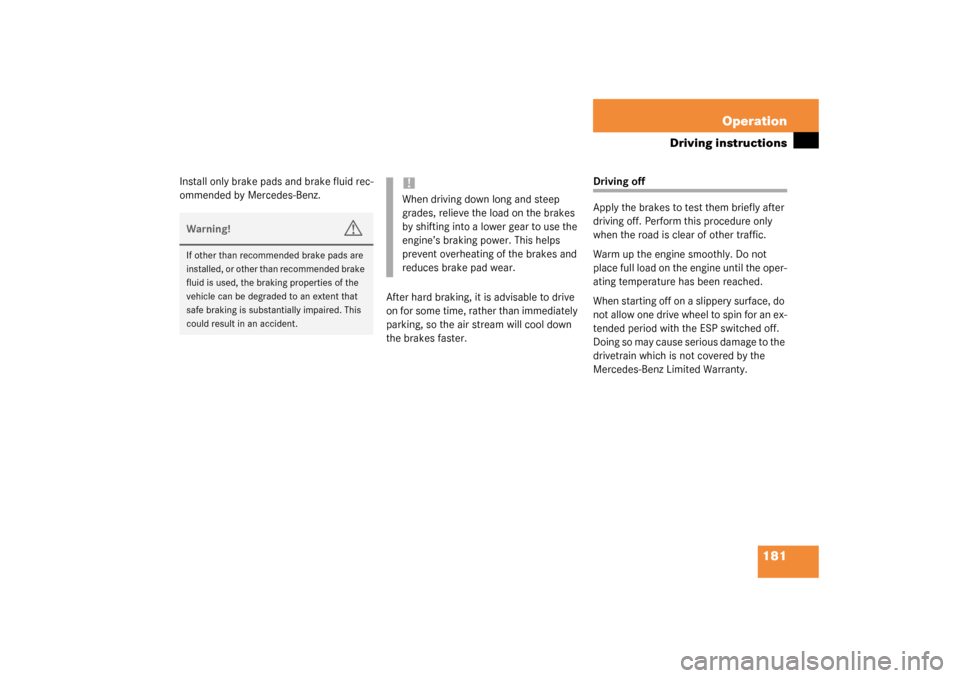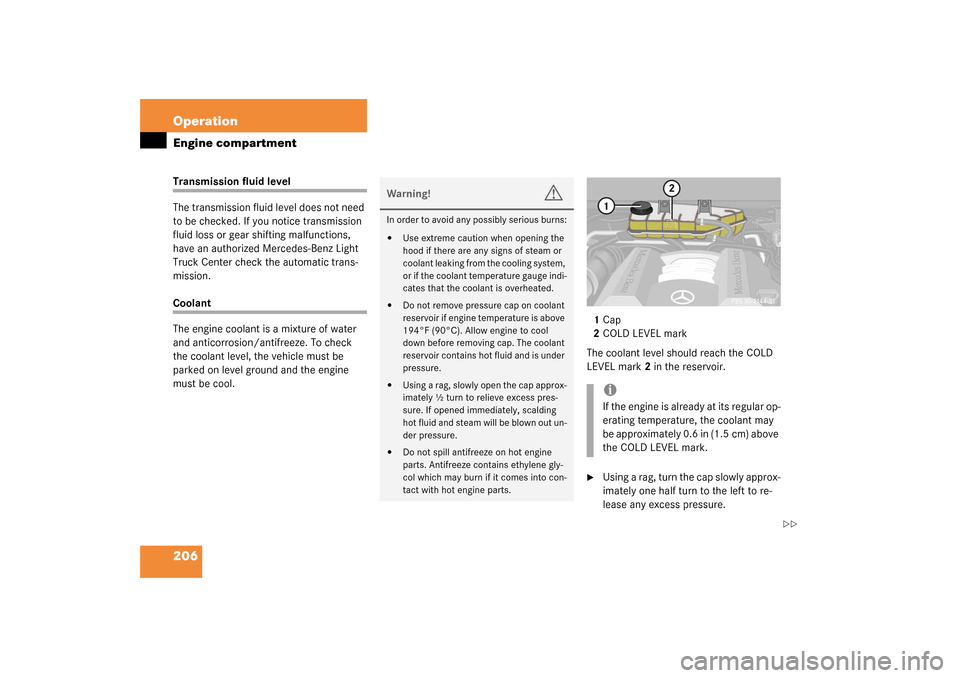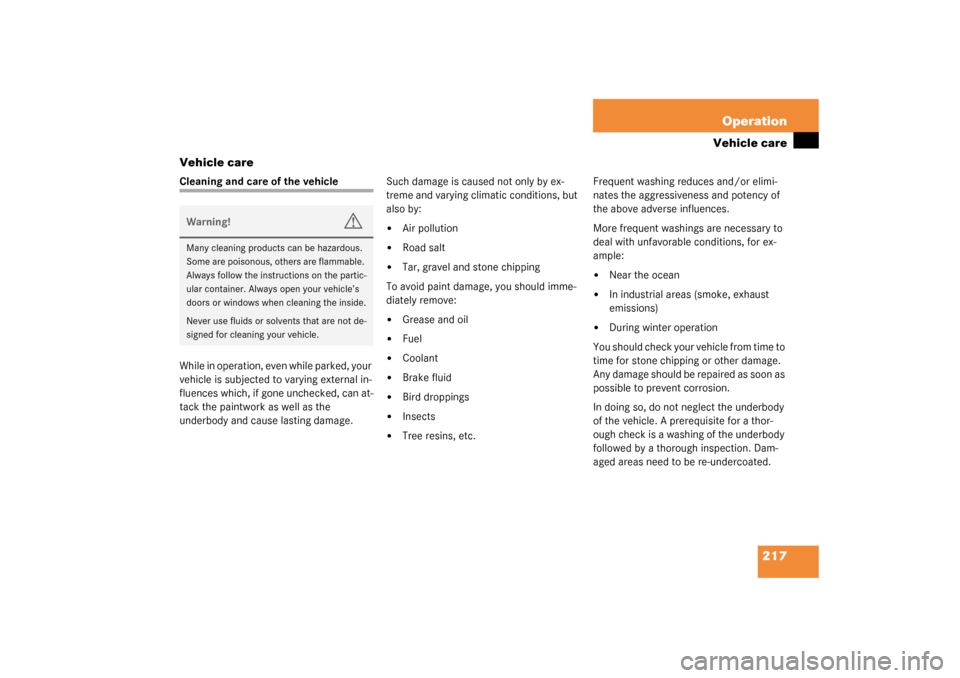Page 181 of 321

181 Operation
Driving instructions
Install only brake pads and brake fluid rec-
ommended by Mercedes-Benz.
After hard braking, it is advisable to drive
on for some time, rather than immediately
parking, so the air stream will cool down
the brakes faster.
Driving off
Apply the brakes to test them briefly after
driving off. Perform this procedure only
when the road is clear of other traffic.
Warm up the engine smoothly. Do not
place full load on the engine until the oper-
ating temperature has been reached.
When starting off on a slippery surface, do
not allow one drive wheel to spin for an ex-
tended period with the ESP switched off.
Doing so may cause serious damage to the
drivetrain which is not covered by the
Mercedes-Benz Limited Warranty.
Warning!
G
If other than recommended brake pads are
installed, or other than recommended brake
fluid is used, the braking properties of the
vehicle can be degraded to an extent that
safe braking is substantially impaired. This
could result in an accident.
!When driving down long and steep
grades, relieve the load on the brakes
by shifting into a lower gear to use the
engine’s braking power. This helps
prevent overheating of the brakes and
reduces brake pad wear.
Page 199 of 321
199 Operation
Driving instructions
Coolant temperature
During severe operating conditions and
stop-and-go city traffic, the coolant tem-
perature may rise to approx. 248°F
(120°C).
The engine should not be operated with
the coolant temperature in the red zone.
Doing so may cause serious engine dam-
age which is not covered by the
Mercedes-Benz Limited Warranty.
Warning!
G
�
Driving when your engine is badly over-
heated can cause some fluids which
may have leaked into the engine com-
partment to catch fire. You could be se-
riously burned
�
Steam from an overheated engine can
cause serious burns and can occur just
by opening the engine hood. Stay away
from the engine if you see or hear steam
coming from it.
Turn off the engine, get out of the vehicle
and do not stand near the vehicle until it
cools down.
Page 201 of 321

201 Operation
At the gas station
Check regularly and before a long trip�
Open the hood (
�page 202)
1Engine oil level
More information on engine oil can be
found in the “Operation” section
(
�page 203).
2Coolant level
For normal replenishing, use water (po-
table water quality). More information
on the coolant level can be found in the
“Operation” section (
�page 206).
3Brake fluid
More information on brake fluid can be
found in the “Technical data” section
(
�page 284).4Windshield washer and headlamp
cleaning system
More information on filling the reser-
voir can be found in the “Operation”
section (
�page 208).
Vehicle lighting
Check function and cleanliness. More in-
formation on replacing light bulbs can be
found in the “Practical hints” section
(
�page 247).
Combination switch (
�page 102).
Tire inflation pressure
More information on tire inflation pressure
can be found in the “Operation” section
(
�page 211).
iLeaving the engine running and the fuel
cap open can cause the
?
lamp to
illuminate.
See also “Practical hints” section
(
�page 232).
Page 206 of 321

206 OperationEngine compartmentTransmission fluid level
The transmission fluid level does not need
to be checked. If you notice transmission
fluid loss or gear shifting malfunctions,
have an authorized Mercedes-Benz Light
Truck Center check the automatic trans-
mission.Coolant
The engine coolant is a mixture of water
and anticorrosion/antifreeze. To check
the coolant level, the vehicle must be
parked on level ground and the engine
must be cool. 1Cap
2COLD LEVEL mark
The coolant level should reach the COLD
LEVEL mark2 in the reservoir.
�
Using a rag, turn the cap slowly approx-
imately one half turn to the left to re-
lease any excess pressure.
Warning!
G
In order to avoid any possibly serious burns:�
Use extreme caution when opening the
hood if there are any signs of steam or
coolant leaking from the cooling system,
or if the coolant temperature gauge indi-
cates that the coolant is overheated.
�
Do not remove pressure cap on coolant
reservoir if engine temperature is above
194°F (90°C). Allow engine to cool
down before removing cap. The coolant
reservoir contains hot fluid and is under
pressure.
�
Using a rag, slowly open the cap approx-
imately ½ turn to relieve excess pres-
sure. If opened immediately, scalding
hot fluid and steam will be blown out un-
der pressure.
�
Do not spill antifreeze on hot engine
parts. Antifreeze contains ethylene gly-
col which may burn if it comes into con-
tact with hot engine parts.
iIf the engine is already at its regular op-
erating temperature, the coolant may
be approximately 0.6 in (1.5 cm) above
the COLD LEVEL mark.
��
Page 208 of 321

208 OperationEngine compartmentWindshield washer system and headlamp cleaning system
The windshield washer reservoir is located
in the engine compartment.
1Cap
Fluid for the windshield washer system and
the headlamp cleaning system* is supplied
from the windshield washer reservoir. It
has a capacity of 8.0 US qt (7.6 l).
During all seasons, add MB Windshield
Washer Concentrate “S” to water. Premix
the windshield washer fluid in a suitable
container.
�
Use the tab to pull cap1 upwards (ar-
row).
�
Refill the reservoir with MB Windshield
Washer Concentrate and water (or
commercially available premixed wind-
shield washer solvent / antifreeze, de-
pending on ambient temperatures).
Always use washer solvent/antifreeze
where temperatures may fall below
freezing. Failure to do so could result in
damage to the washer system/reser-
voir.
More information can be found in the
“Technical data” section (
�page 290).
Warning!
G
Washer solvent/antifreeze is highly flamma-
ble. Do not spill washer solvent/antifreeze
on hot engine parts, because it may ignite.
You could be seriously burned.
!Only use washer fluid which is suitable
for plastic lenses. Improper washer flu-
id can damage the plastic lenses of the
headlamps.
Page 217 of 321

217 Operation
Vehicle care
Vehicle care
Cleaning and care of the vehicle
While in operation, even while parked, your
vehicle is subjected to varying external in-
fluences which, if gone unchecked, can at-
tack the paintwork as well as the
underbody and cause lasting damage.Such damage is caused not only by ex-
treme and varying climatic conditions, but
also by:
�
Air pollution
�
Road salt
�
Tar, gravel and stone chipping
To avoid paint damage, you should imme-
diately remove:
�
Grease and oil
�
Fuel
�
Coolant
�
Brake fluid
�
Bird droppings
�
Insects
�
Tree resins, etc.Frequent washing reduces and/or elimi-
nates the aggressiveness and potency of
the above adverse influences.
More frequent washings are necessary to
deal with unfavorable conditions, for ex-
ample:
�
Near the ocean
�
In industrial areas (smoke, exhaust
emissions)
�
During winter operation
You should check your vehicle from time to
time for stone chipping or other damage.
A n y d a m a g e s h o u l d b e r e p a i r e d a s s o o n a s
possible to prevent corrosion.
In doing so, do not neglect the underbody
of the vehicle. A prerequisite for a thor-
ough check is a washing of the underbody
followed by a thorough inspection. Dam-
aged areas need to be re-undercoated.
Warning!
G
Many cleaning products can be hazardous.
Some are poisonous, others are flammable.
Always follow the instructions on the partic-
ular container. Always open your vehicle’s
doors or windows when cleaning the inside.
Never use fluids or solvents that are not de-
signed for cleaning your vehicle.
Page 228 of 321

228 Practical hintsWhat to do if …Problem
Possible cause
Suggested solution
É
The red brake warning lamp
lights up while driving and you
hear a warning sound.
You are driving with the parking brake set.
�
Release the parking brake
(�page 45).
É
The red brake warning lamp
lights up while driving.
There is insufficient brake fluid in the reser-
voir.
�
Risk of accident! Carefully stop the
vehicle and notify an authorized
Mercedes-Benz Light Truck Center.
Do not add brake fluid! This will not
solve the problem.
Warning!
G
Driving with the brake warning lamp illumi-
nated can result in an accident. Have your
brake system checked immediately if the
brake warning lamp stays on. Don’t add
brake fluid before checking the brake sys-
tem. Overfilling the brake fluid reservoir can
result in spilling brake fluid on hot engine
parts and the brake fluid catching fire. You
can be seriously burned.
!If you find that the brake fluid in the
brake fluid reservoir has fallen to the
minimum mark or below, have the
brake system checked for brake pad
thickness and leaks.
Page 231 of 321
231 Practical hints
What to do if …
Warning!
G
Driving when your engine is badly overheat-
ed can cause some fluids which may have
leaked into the engine compartment to
catch fire. You could be seriously burned.
Steam from an overheated engine can cause
serious burns and can occur just by opening
the engine hood. Stay away from the engine
if you see or hear steam coming from it.
Turn off the engine, get out of the vehicle
and do not stand near the vehicle until it
cools down.Warning!
G
Do not spill antifreeze on hot engine parts.
Antifreeze contains ethylene glycol which
may burn if it comes into contact with hot
engine parts. You can be seriously burned.
!Do not ignore the coolant warning
lamps. Extended driving with the sym-
bol displayed may cause serious engine
damage not covered by the
Mercedes-Benz Limited Warranty.
Do not drive without sufficient amount
of coolant. The engine will overheat,
causing major engine damage.